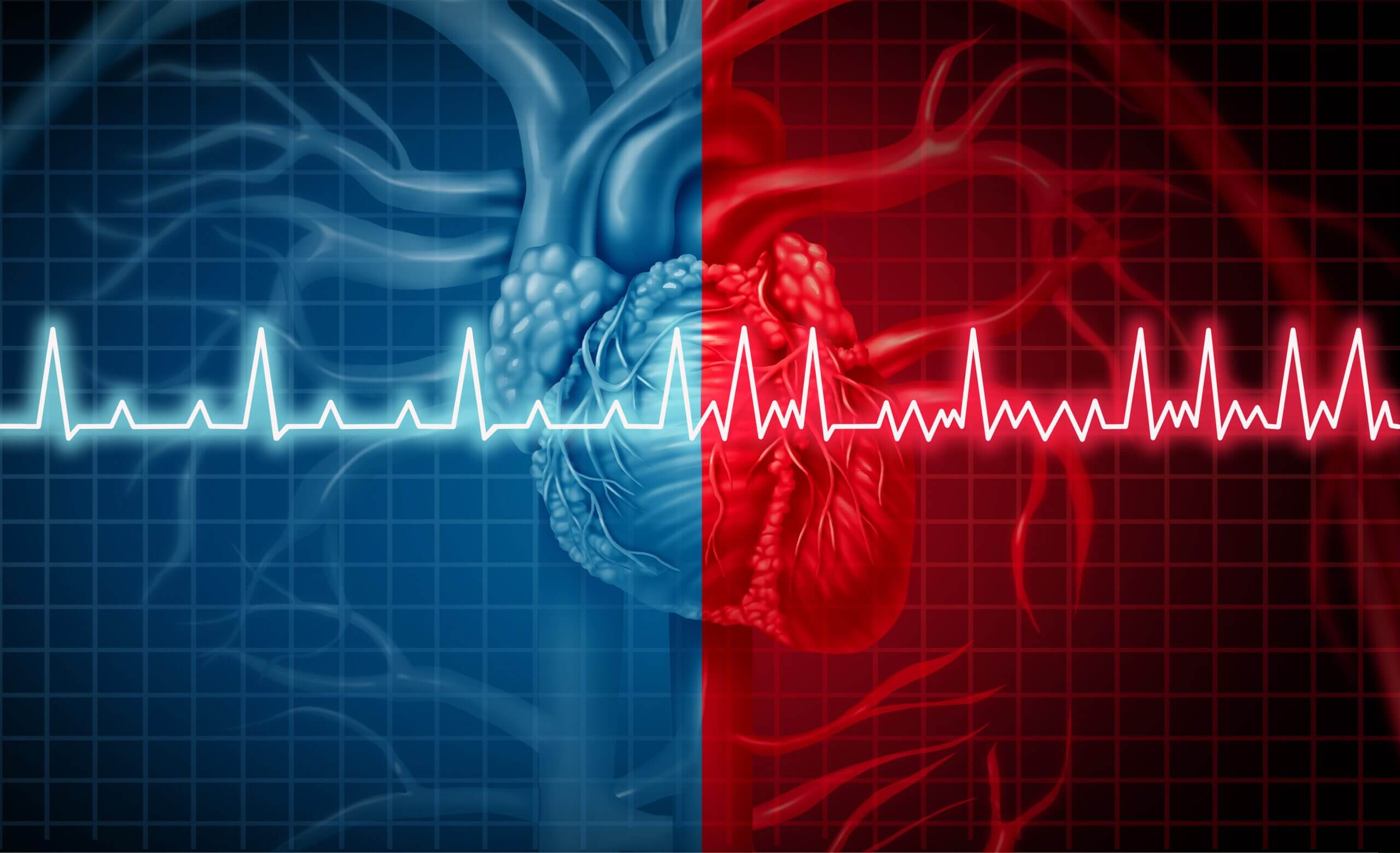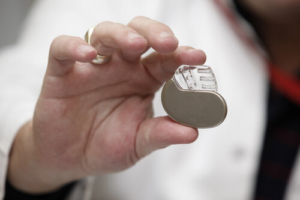Imagine experiencing an irregular heartbeat, uncertain if it’s just a fleeting sensation or a sign of a more serious condition. Atrial fibrillation (AFib) is the most common heart rhythm disturbance, affecting millions of people worldwide. Being able to recognize what is a dangerous heart rate with AFib is crucial for preventing life-threatening complications. In this blog post, I’ll provide a comprehensive guide on understanding AFib, recognizing dangerous heart rates, managing heart rate in AFib, and monitoring your heart health. Let’s embark on this journey towards better heart health together.
Key Takeaways
- Atrial fibrillation is a type of arrhythmia that can cause dangerous heart rates exceeding the normal range.
- Various age, fitness level, medications and health conditions influence the risk of developing complications from AFib.
- Managing atrial fibrillation involves lifestyle changes, medication and medical procedures to reduce the risk of serious complications from dangerous heart rate.
Understanding Atrial Fibrillation
Atrial fibrillation is an abnormal heart rhythm and a common form of heart disease. It can cause serious health issues such as blood clots, stroke, and even heart failure. It occurs when abnormal electrical impulses in the heart’s upper chambers disrupt the normal rhythm, causing the heart to beat irregularly and rapidly. This common heart rhythm disturbance affects people of all ages and is often associated with other heart conditions, high blood pressure, and obesity.
When left untreated, AFib can result in serious complications and a diminished quality of life.
Types of Atrial Fibrillation
There are three primary types of atrial fibrillation:
- Paroxysmal atrial fibrillation: characterized by sudden onset and cessation of symptoms, typically lasting for less than a week. In paroxysmal atrial fibrillation, patients are in nromal rhythm most of the time.
- Persistent atrial fibrillation: continuous AFib that lasts for a period exceeding one week but not more than one year.
- Permanent atrial fibrillation: continues AFib that persists for over 12 months and is generally not reversible.
Each type has distinct durations and treatment approaches.
Atrial flutter is another abnormal heart rhythm that is closely related to atrial fibrillation, but with a more organized and less disordered rhythm in the atria.
Recognizing Dangerous Heart Rates in AFib
There is no specific heart rate that is considered a dangerous heart rate by itself. However, individual factors may influence what is considered dangerous for each person. The normal heart rate is between 60 to 100 beats per minute, but when atrial fibrillation occurs, the heart rate can become rapid and irregular and may exceed this range. It is not uncommon to see patients with atrial fibrillation with heart rates of 120, 150, or 180 bpm, or even higher.
Particularly for those experiencing symptoms of atrial fibrillation, keeping a close eye on your heart rate is paramount.
Factors Influencing Heart Rate
Several factors can impact the heart rate of someone with AFib, including:
- Age
- Fitness level
- Medications
- Other health conditions
For instance, an elderly individual may have a higher heart rate than a younger person, and medications can also increase or decrease the heart rate. Furthermore, other health conditions such as high blood pressure or diabetes can also affect the heart rate.
In addition to these factors, physical activity, stress levels, body temperature, and overall health can all have an impact on heart rate. Pinpointing these factors are key to managing heart rate in AFib and reducing the risk of complications. Addressing these factors enables individuals with AFib to have better control over their heart rate and lead a healthier lifestyle.
Symptoms Indicating a Dangerous Heart Rate
Identifying the symptoms of a dangerous heart rate in AFib is key to timely medical intervention and preventing complications. Frequently it is not the heart rate itself but the symptoms which can indicate a dangerous heart rate and the need for urgent medical attention. Symptoms may include:
- Chest pain
- Shortness of breath
- Dizziness
- Fainting
Immediate medical attention is necessary if you experience any of these symptoms, given the serious complications atrial fibrillation can lead to.
Maintaining vigilance about your heart health and being cognizant of the warning signs indicating a dangerous heart rate is vital. Early detection and intervention can make a significant difference in the management of AFib and the prevention of life-threatening complications.

Managing Heart Rate in AFib
Long term treatment options for managing heart rate in AFib include lifestyle changes, medications, and medical procedures. Adopting a comprehensive treatment plan allows individuals with AFib to effectively manage their heart rate and lower the risk of complications.
Working closely with healthcare professionals to tailor the most suitable treatment plan as per individual needs and medical history is of utmost importance.
Lifestyle Changes
Adopting a healthy lifestyle can play a significant role in managing heart rate in AFib. Regular exercise has been shown to reduce the risk of developing AFib and help manage heart rate in those who already have it. Maintaining a balanced diet can also decrease the likelihood of developing AFib and aid in controlling heart rate in individuals who already have it.
Furthermore, stress management can aid in the reduction of the likelihood of developing AFib and assist in the regulation of the heart rate in those who already have it. By incorporating these lifestyle changes, individuals with AFib can take control of their heart health and minimize the risk of developing dangerous heart rates or complications associated with the condition.
Medications
Medications such as beta-blockers, calcium channel blockers, and anti-arrhythmic drugs can help control heart rate in AFib patients. These medications work by regulating the electrical signals in the heart, helping to maintain a more stable heart rhythm. Adherence to the prescribed treatment plan and seeking advice from healthcare professionals in case of side effects, concerns or queries is necessary.
Anti-arrhythmic medications can be tailored to an individual’s needs, and in some cases, more than one medication may be required to effectively control atrial fibrillation. Collaborating closely with healthcare professionals to establish the most suitable medication regimen in line with individual needs and medical history is imperative.
Medical Procedures
Medical procedures like cardioversion, catheter ablation, and pacemaker implantation can help manage heart rate in AFib. Here are some details about each procedure.
- Cardioversion: This procedure uses a controlled electric shock to restore normal heart rhythm.
- Catheter ablation: This minimally invasive procedure involves guiding catheters through a vein into the heart to record electrical activity and ablate the tissue causing the abnormal rhythm. This can be a good long term treatment option for many people with atrial fibrillation.
- Pacemaker implantation: This procedure involves inserting a small device into the chest to regulate the heart rate and can help control AFib symptoms.
These procedures can provide effective solutions for managing heart rate in AFib patients when medications and lifestyle changes are not sufficient. Discussing the potential risks and benefits of these procedures with healthcare professionals to establish the most suitable treatment plan is key.
Can I Control an AFib Attack and Lower Heart Rate at Home?
I highly recommend that all people diagnosed with AFib discuss at-home symptom management strategies with their doctor. During mild attacks, it is possible for a person trained in symptom reducing techniques to manage their symptoms without the need for medical intervention.
In some cases, it’s possible to manage a mild AFib attack at home using natural methods or maneuvers. Deep breathing exercises, yoga, and meditation can help to slow your heart rate by promoting relaxation and reducing stress. The Valsalva maneuver, which involves holding your breath and straining as if you are trying to have a bowel movement, can sometimes help to restore normal heart rhythm. However, these methods should be used in conjunction with, and not as a replacement for, medical treatment. Always consult your healthcare provider before trying these strategies to manage your AFib at home.
Things like regular baseline assessment, heart rate monitoring, and at-home ECG devices can be very helpful for those living with atrial fibrillation. For more information about at-home options for managing AFib, please read my article about common ways to stop an AFib attack.
What Will They Do in the ER to Treat AFib?
A common barrier to people seeking medical attention for an AFib attack is a lack of education about what the medical providers in the emergency room will do to manage their symptoms.
The most common intervention performed in the emergency room for patients with atrial fibrillation is the use of heart rate and rhythm altering medications. These medications will be used to reduce the speed and normalize the rhythm of the heart to reduce the severity of symptoms. The most commonly used AFib medications in the emergency room include:
- Metoprolol
- Amiodarone
- Diltiazem
- Digoxin
All the medications above are available in intravenous forms and provide relatively rapid onset of action. Metoprolol, diltiazem, and digoxin are mostly used for heart rate control. Meanwhile, amiodarone has both heart rate and heart rhythm controlling properties. There are pros and cons with the use of any of these medications, and thus, their use needs to be monitored closely.
Your team of medical staff will monitor your symptoms before, during, and after these medications are used to control your episode. Medical testing such as vital monitoring and ECG readings may also be done to evaluate the success of the treatment. In severe cases, a patient may require electrical cardioversion or emergency surgery if their heart rate cannot be normalized and their symptoms are profound.
Complications from Dangerous Heart Rates
Complications of a dangerous heart rate in AFib include stroke, heart failure, and other heart-related issues. Blood clots can form as a result of atrial fibrillation, leading to an increased risk of stroke. The risk of stroke associated with AFib increases with age and other health conditions, such as high blood pressure and diabetes.
Grasping the potential complications of dangerous heart rates in AFib enables individuals with the condition to take suitable measures to manage their heart health and mitigate the risk of life-threatening complications.
Preventing Dangerous Heart Rates
Preventing dangerous heart rates in AFib involves managing risk factors, adopting a healthy lifestyle, and following prescribed treatment plans. Blood thinners are typically prescribed to mitigate the risk of blood clots and strokes in individuals with atrial fibrillation. Additionally, engaging in regular exercise, consuming a nutritious diet, and abstaining from alcohol and tobacco can help mitigate the risk of dangerous heart rates.
Addressing these factors and partnering with healthcare professionals allows individuals with AfFb to manage their heart health effectively and reduce the likelihood of developing dangerous heart rates or complications associated with the condition.
Monitoring Heart Rate with AFib
Frequent monitoring of heart rate, both independently at home and through medical check-ups, is paramount for individuals with AFib to ensure effective management and prevent complications. Heart rate monitors or wearable devices that track heart rate can provide real-time data and detect changes in heart rate, and have become a very valuable tool for patients with AFib. Additionally, individuals can manually check their pulse by placing two fingers on their wrist or neck and counting the number of beats in a minute.
Monitoring heart rate enables individuals with AFib to identify potential issues early and seek appropriate medical intervention. Remaining vigilant about heart health and routinely monitoring heart rate enables individuals with AFib to manage their condition more effectively and reduce the risk of complications.
Summary
Understanding and managing heart rate in atrial fibrillation is crucial for maintaining heart health and preventing life-threatening complications. By learning about the different types of atrial fibrillation, recognizing dangerous heart rates, adopting a healthy lifestyle, and following prescribed treatment plans, individuals with Afib can take control of their heart health and minimize the risk of complications. Regular heart rate monitoring is an essential component of managing AFib and ensuring proper treatment and care.
Take charge of your heart health today by incorporating the knowledge and strategies discussed in this blog post. Remember, a healthy heart is a happy heart.
Frequently Asked Questions
At what heart rate should you go to the ER with AFib?
It is not always the heart rate or duration which should lead someone to go to the ER for urgent medical attention. Symptoms such as chest pain, severe shortness of breath, or dizziness are a more reliable guide of when to go to the ER for urgent medical attention.
Don’t hesitate – if you feel something is ‘off’ about your body, check your pulse and take action.
How do I stop worrying about AFib?
Knowledge is power, so take the time to understand AFib and how it impacts your life. Ways to reduce anxiety include getting regular exercise, keeping a thought log of anxiety triggers, practicing yoga and relaxation techniques, and engaging in meditation and walking.
Natural remedies, counseling, medications and support from family and friends can also help manage fear and anxiety associated with AFib.
What causes extreme fluctuations in heart rate?
Anxiety, caffeine, nicotine, and various drugs can all cause extreme fluctuations in heart rate, as can hypothyroidism, certain heart diseases, lung diseases, and pulmonary embolism.
Hypothyroidism, heart diseases, lung diseases, and pulmonary embolism can all cause changes in heart rate. These changes can be extreme and can be caused by a variety of factors, including anxiety, caffeine, nicotine, and drugs.
What is Atrial Fibrillation?
Atrial fibrillation is an irregular heart rhythm that can lead to serious health problems, such as blood clots, stroke and heart failure.
It occurs when chaotic electrical signals in the heart’s upper chambers disrupt normal rhythm, resulting in an irregular heartbeat.
What are the symptoms of a dangerous heart rate in AFib?
Symptoms of a dangerous heart rate in Afib include chest pain, shortness of breath, dizziness, and fainting, which can be life-threatening.
It is important to seek medical attention immediately if these symptoms appear.
The Best Atrial Fibrillation Book
Your Complete Guide To AFib: The Essential Manual For Every Patient With Atrial Fibrillation
$15.95 (as of April 26, 2024 10:31 GMT -06:00 - More infoProduct prices and availability are accurate as of the date/time indicated and are subject to change. Any price and availability information displayed on [relevant Amazon Site(s), as applicable] at the time of purchase will apply to the purchase of this product.) The A to Z guide on everything you need to know about atrial fibrillation. Written by AFib expert Dr. Percy Morales MD. Over 120 pages of essential information on medications, procedures, and lifestyles modifications for AFib. Easy to read for every patient.
Shop AFib Products on Amazon
KardiaMobile 6-Lead Personal EKG Monitor – Six Views of The Heart – Detects AFib and Irregular Arrhythmias – Instant Results in 30 Seconds – Works with Most Smartphones - FSA/HSA Eligible

KardiaMobile 1-Lead Personal EKG Monitor – Record EKGs at Home – Detects AFib and Irregular Arrhythmias – Instant Results in 30 Seconds – Easy to Use – Works with Most Smartphones - FSA/HSA Eligible

Apple Watch Series 9 [GPS 41mm] Smartwatch with Storm Blue Aluminum Case with Silver Sport Band M/L. Fitness Tracker, Blood Oxygen & ECG Apps, Always-On Retina Display

Fitbit Sense 2 Advanced Health and Fitness Smartwatch with Tools to Manage Stress and Sleep, ECG App, SpO2, 24/7 Heart Rate and GPS, Shadow Grey/Graphite, One Size (S & L Bands Included)

OMRON - Complete Wireless Upper Arm Blood Pressure Monitor + EKG - Built-in Bluetooth Technology

Omron Hem 7361T Bluetooth Digital Blood Pressure Monitor with Afib Indicator and 360° Accuracy Intelliwrap Cuff for Most Accurate Measurements (White)

EMAY Portable ECG Monitor | Record ECG and Heart Rate Anytime Anywhere | Stand-Alone Device with LCD Screen and Storage | No Subscription Required

Samsung Galaxy Watch 6 44mm Smartwatch with HR Zones, Sleep Coaching, Heart Monitor - Graphite

Natural Rhythm Triple Calm Magnesium 150 mg - 120 Capsules – Magnesium Complex Compound Supplement with Magnesium Glycinate, Malate, and Taurate. Calming Blend for Promoting Rest and Relaxation.

Pure Encapsulations Magnesium (Glycinate) - Supplement to Support Stress Relief, Sleep, Heart Health, Nerves, Muscles, and Metabolism* - with Magnesium Glycinate - 180 Capsules


















![Apple Watch Series 9 [GPS 41mm] Smartwatch with Storm Blue Aluminum Case with Silver Sport Band M/L. Fitness Tracker, Blood Oxygen & ECG Apps, Always-On Retina Display #1](https://m.media-amazon.com/images/I/311xwtp4mFL._SL100_.jpg)
![Apple Watch Series 9 [GPS 41mm] Smartwatch with Storm Blue Aluminum Case with Silver Sport Band M/L. Fitness Tracker, Blood Oxygen & ECG Apps, Always-On Retina Display #2](https://m.media-amazon.com/images/I/41j+8AaUGsL._SL100_.jpg)
![Apple Watch Series 9 [GPS 41mm] Smartwatch with Storm Blue Aluminum Case with Silver Sport Band M/L. Fitness Tracker, Blood Oxygen & ECG Apps, Always-On Retina Display #3](https://m.media-amazon.com/images/I/41jIyxZitnL._SL100_.jpg)
![Apple Watch Series 9 [GPS 41mm] Smartwatch with Storm Blue Aluminum Case with Silver Sport Band M/L. Fitness Tracker, Blood Oxygen & ECG Apps, Always-On Retina Display #4](https://m.media-amazon.com/images/I/41IpNJERjCL._SL100_.jpg)
![Apple Watch Series 9 [GPS 41mm] Smartwatch with Storm Blue Aluminum Case with Silver Sport Band M/L. Fitness Tracker, Blood Oxygen & ECG Apps, Always-On Retina Display #5](https://m.media-amazon.com/images/I/31o17yhfYpL._SL100_.jpg)

















































